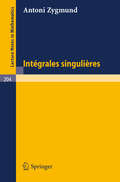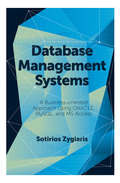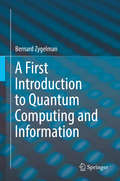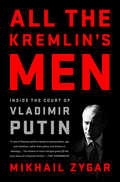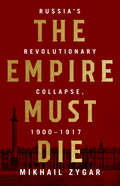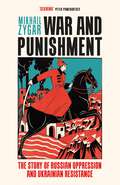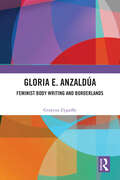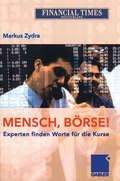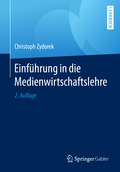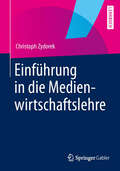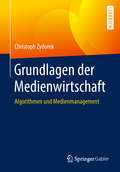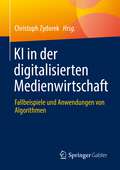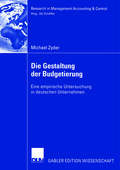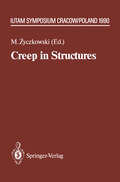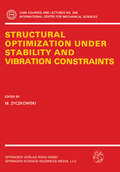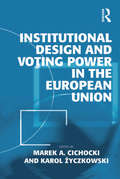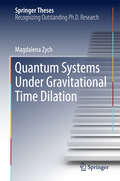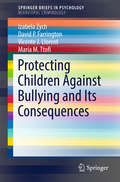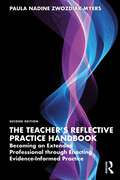- Table View
- List View
Database Management Systems: A Business-Oriented Approach to ORACLE, MySQL and MS Access (PDF)
by Sotirios ZygiarisMore and more, the advance of enterprise computing and cloud technologies means that managers are responsible for retrieving data ad-hoc and constructing business reports for decision-making and storytelling. The technical competencies necessary for such tasks can be daunting, and most database teaching methods do little to mitigate the confusion. They tend to follow traditional computer science methods that expose all computational and matrix theory complexities as well as various design theories, and in so doing, they present an excess of information that unnecessarily complicates the learning process for business-minded readers. Zygiaris simplifies his teaching method in order to provide an accessible walkthrough of all technological advances of databases in the business environment. Readers learn how to design, develop, and use databases to provide business analytical reports with the three major database management systems: Microsoft Access, Oracle Express and MariaDB (formerly MySQL). This is all delivered through clearly structured, streamlined chapters, all of which link to online videos that demonstrate visually, in step-by-step tutorials, how to implement the processes outlined in the book. All of these features help the non-IT student or manager to understand the importance of databases in the business environment and to learn how to use those databases to solve real-world problems. This book is of particular interest to students of management and to business managers, and it is of keen interest to anyone who works with major business database systems.
Database Management Systems: A Business-Oriented Approach to ORACLE, MySQL and MS Access
by Sotirios ZygiarisMore and more, the advance of enterprise computing and cloud technologies means that managers are responsible for retrieving data ad-hoc and constructing business reports for decision-making and storytelling. The technical competencies necessary for such tasks can be daunting, and most database teaching methods do little to mitigate the confusion. They tend to follow traditional computer science methods that expose all computational and matrix theory complexities as well as various design theories, and in so doing, they present an excess of information that unnecessarily complicates the learning process for business-minded readers. Zygiaris simplifies his teaching method in order to provide an accessible walkthrough of all technological advances of databases in the business environment. Readers learn how to design, develop, and use databases to provide business analytical reports with the three major database management systems: Microsoft Access, Oracle Express and MariaDB (formerly MySQL). This is all delivered through clearly structured, streamlined chapters, all of which link to online videos that demonstrate visually, in step-by-step tutorials, how to implement the processes outlined in the book. All of these features help the non-IT student or manager to understand the importance of databases in the business environment and to learn how to use those databases to solve real-world problems. This book is of particular interest to students of management and to business managers, and it is of keen interest to anyone who works with major business database systems.
A First Introduction to Quantum Computing and Information
by Bernard ZygelmanThis book addresses and introduces new developments in the field of Quantum Information and Computing (QIC) for a primary audience of undergraduate students. Developments over the past few decades have spurred the need for QIC courseware at major research institutions. This book broadens the exposure of QIC science to the undergraduate market. The subject matter is introduced in such a way so that it is accessible to students with only a first-year calculus background. Greater accessibility allows a broader range of academic offerings. Courses, based on this book, could be offered in the Physics, Engineering, Math and Computer Science departments. This textbook incorporates Mathematica-based examples into the book. In this way students are allowed a hands-on experience in which difficult abstract concepts are actualized by simulations. The students can ‘turn knobs" in parameter space and explore how the system under study responds. The incorporation of symbolic manipulation software into course-ware allows a more holistic approach to the teaching of difficult concepts. Mathematica software is used here because it is easy to use and allows a fast learning curve for students who have limited experience with scientific programming.
All the Kremlin's Men: Inside the Court of Vladimir Putin
by Mikhail ZygarAn extraordinary behind-the-scenes portrait of the court of Vladimir Putin, the oligarchs that surround it, and the many moods of modern Russia that reads like a "real House of Cards"(Lev Lurie).All the Kremlin's Men is a gripping narrative of an accidental king and a court out of control. Based on an unprecedented series of interviews with Vladimir Putin's inner circle, this book presents a radically different view of power and politics in Russia. The image of Putin as a strongman is dissolved. In its place is a weary figurehead buffeted--if not controlled--by the men who at once advise and deceive him.The regional governors and bureaucratic leaders are immovable objects, far more powerful in their fiefdoms than the president himself. So are the gatekeepers-those officials who guard the pathways to power-on whom Putin depends as much as they rely on him. The tenuous edifice is filled with all of the intrigue and plotting of a Medici court, as enemies of the state are invented and wars begun to justify personal gains, internal rivalries, or one faction's biased advantage.A bestseller in Russia, All the Kremlin's Men is a shocking revisionist portrait of the Putin era and a dazzling reconstruction of the machinations of courtiers running riot.
The Empire Must Die: Russia's Revolutionary Collapse, 1900-1917
by Mikhail ZygarFrom Tolstoy to Lenin, from Diaghilev to Stalin, The Empire Must Die is a tragedy of operatic proportions with a cast of characters that ranges from the exotic to utterly villainous, the glamorous to the depraved.In 1912, Russia experienced a flowering of liberalism and tolerance that placed it at the forefront of the modern world: women were fighting for the right to vote in the elections for the newly empowered parliament, Russian art and culture was the envy of Europe and America, there was a vibrant free press and intellectual life. But a fatal flaw was left uncorrected: Russia's exuberant experimental moment took place atop a rotten foundation. The old imperial order, in place for three hundred years, still held the nation in thrall. Its princes, archdukes, and generals bled the country dry during the First World War and by 1917 the only consensus was that the Empire must die.Mikhail Zygar's dazzling, in-the-moment retelling of the two decades that prefigured the death of the Tsar, his family, and the entire imperial edifice is a captivating drama of what might have been versus what was subsequently seen as inevitable. A monumental piece of political theater that only Russia was capable of enacting, the fall of the Russian Empire changed the course of the twentieth century and eerily anticipated the mood of the twenty-first.
War and Punishment: The Story of Russian Oppression and Ukrainian Resistance
by Mikhail Zygar'History is made up of myths,' writes the renowned Russian dissident journalist Mikhail Zygar. 'Alas, our myths led us to the fascism of 2022. It is time to expose them.' Drawing from his perilous career investigating the frontiers of the Russian empire, Zygar reveals how 350 years of propaganda, bad historical scholarship, folk tales and fantasy spurred his nation into war with Ukraine.How did a German monk's fear of the Ottoman Empire drive him to invent the fiction of a united Russian world? How did corny spy novels about a 'Soviet James Bond' inspire Vladimir Putin to join the KGB? How did Alexander Pushkin's admiration for a poem by Lord Byron end with him slandering the legendary chief of the Cossacks? And how did Putin underestimate a rising TV comic named Volodymyr Zelensky, failing to see that his satire had become deadly serious, and that his country would be a joke no longer?A noted expert on the Kremlin with unparalleled access to hundreds of players in the current conflict - from politicians to oligarchs, gangsters to comedians (not least Zelensky himself) - Zygar chronicles the power struggles from which today's politics grew, and digs out the essential truths from behind layers of seductive legend. By surveying the strange, complex record of Russo-Ukrainian relations, War and Punishment reveals exactly how the largest nation on Earth lost its senses. A work of history can't undo the past or transform the present, but sometimes it can shape the future.In fact, that's how the story begins.
Gloria E. Anzaldúa: Feminist Body Writing and Borderlands
by Grażyna ZygadłoGloria E. Anzaldúa is a crucial figure in contemporary border and women’s studies. When in 1987 she published her groundbreaking book Borderlands/La Frontera: The New Mestiza, she became one of the most often quoted writers of the US–Mexico border, but she remains relatively little known outside Americas. In one of the first monographs written on her work, Grażna Zygadło introduces Anzaldúa’s work and outlines her feminist revisionist thinking to new audiences, especially in Europe. The author defines these borderlands as areas where numerous systems of power, exploitation, and oppression intersect – capitalism, patriarchy, racism, and white man’s supremacy. She also concentrates on the innovative philosophy of women’s writing from the body that Anzaldúa has propagated and on her formative role in the women of color feminism. Zygadło also works to expand Anzaldúa’s borderland thinking by applying it to the recent issues related to migration crisis and border problems in the European Union – namely the contradictory treatment of refugees at the Polish eastern border. Gloria E. Anzaldúa is situated at the intersection of various disciplines, in particular, American cultural studies, feminist criticism, and Latin American postcolonial studies, and is a valuable source of knowledge about Anzaldúa’s ideas for undergraduate and graduate students.
Gloria E. Anzaldúa: Feminist Body Writing and Borderlands
by Grażyna ZygadłoGloria E. Anzaldúa is a crucial figure in contemporary border and women’s studies. When in 1987 she published her groundbreaking book Borderlands/La Frontera: The New Mestiza, she became one of the most often quoted writers of the US–Mexico border, but she remains relatively little known outside Americas. In one of the first monographs written on her work, Grażna Zygadło introduces Anzaldúa’s work and outlines her feminist revisionist thinking to new audiences, especially in Europe. The author defines these borderlands as areas where numerous systems of power, exploitation, and oppression intersect – capitalism, patriarchy, racism, and white man’s supremacy. She also concentrates on the innovative philosophy of women’s writing from the body that Anzaldúa has propagated and on her formative role in the women of color feminism. Zygadło also works to expand Anzaldúa’s borderland thinking by applying it to the recent issues related to migration crisis and border problems in the European Union – namely the contradictory treatment of refugees at the Polish eastern border. Gloria E. Anzaldúa is situated at the intersection of various disciplines, in particular, American cultural studies, feminist criticism, and Latin American postcolonial studies, and is a valuable source of knowledge about Anzaldúa’s ideas for undergraduate and graduate students.
Mensch, Börse!: Experten finden Worte für die Kurse
by Markus ZydraDas Buch will emotionale Lust auf Börse wecken. Ausgewählte Experten erklären das Börsengeschehen verständlich. Die Beiträge machen die Anleger fit und helfen, das Geheimnisvolle, das die Börse für Nicht-Insider immer noch umgibt, zu entschleiern.
Einführung in die Medienwirtschaftslehre
by Christoph ZydorekDas Lehrbuch dient als Einführung in die Grundfragen und als Vorbereitung auf eine tiefergehende Durchdringung des medienwirtschaftlichen Handlungsbereichs. Welche medienökonomischen Anknüpfungspunkte haben speziell Studierende als Abnehmer und künftige Produzenten von Medien(inhalten)? Diese Einstiegsfrage verdeutlicht auf einfache Weise die Sinnhaftigkeit einer systematischen Durchdringung des Themas Medienökonomie auf dem Niveau einer Einführung für das Grundstudium in Medienstudiengängen. Das Lehrbuch führt die wichtigsten Begriffe ein: Medienträger, Content, Wertschöpfung, Güter, Bedürfnisbefriedigung mit Medien, Medien als Wirtschafts- und Kulturgüter. Christoph Zydorek stellt die drei Haupt-Akteurstypen (Rezipient, Medienunternehmen, Werbetreibende Wirtschaft) auf Medienmärkten mit ihren jeweiligen Handlungsmotivationen sowie die zentralen Eigenschaften von Mediengütern vor. Die 2. Auflage wurde grundlegend überarbeitet und aktualisiert.
Einführung in die Medienwirtschaftslehre
by Christoph ZydorekWelche medienökonomischen Anknüpfungspunkte haben speziell Studierende als Abnehmer und künftige Produzenten von Medien? Diese Einstiegsfrage verdeutlicht auf einfache Weise die Sinnhaftigkeit einer systematischen Durchdringung des Themas Medienökonomie und führt die wichtigsten Begriffe ein: Medien, Inhalt, Wertschöpfung, Güter, Bedürfnisbefriedigung mit Medien, Medien als Wirtschafts- und Kulturgüter. Christoph Zydorek stellt die drei Haupt-Akteurstypen (Rezipient, Medienunternehmen, werbetreibende Wirtschaft) auf Medienmärkten mit ihren jeweiligen Handlungsmotivationen sowie danach die zentralen Eigenschaften von Mediengütern vor. Darauf aufbauend können einige Mainstream-Handlungskonzepte aus der Sicht der Hersteller von Mediendienstleistungen diskutiert werden: Preis- und Erlöspolitik, Bündelung, Versionierung, Windowing. Das Lehrbuch dient als Einführung in die Grundfragen und als Vorbereitung auf eine tiefergehende Durchdringung des medienwirtschaftlichen Handlungsbereichs.
Grundlagen der Medienwirtschaft: Algorithmen und Medienmanagement
by Christoph ZydorekDieses Lehrbuch setzt an den Inhalten des Bandes "Einführung in die Medienwirtschaftslehre" von Christoph Zydorek an und erweitert diese entsprechend den Anforderungen von medienbezogenen Masterstudiengängen. Dabei wird ein hochaktuelles und für die Medienwirtschaft hoch bedeutsames Thema fokussiert: der Einsatz von Algorithmen in Verbindung mit großen Datenmengen in alltäglichen medienwirtschaftlichen Zusammenhängen. Es wird analysiert, auf welche Weise Medienunternehmen in jüngster Zeit veränderte technische Rahmenbedingungen für ihre Leistungserstellungs-, Leistungsangebots-, Interaktions- und Distributionskonfigurationen nutzen, um damit den seit jeher gegebenen ökonomischen Herausforderungen zu begegnen, die sie bei der Produktion und Vermarktung medialer Inhalteangebote haben. Nachdem der Algorithmusbegriff und seine medienwirtschaftlichen Zusammenhänge erläutert wurden, diskutiert der Autor konkrete Beispiele, die die aktuellen Veränderungen illustrieren.
KI in der digitalisierten Medienwirtschaft: Fallbeispiele und Anwendungen von Algorithmen
by Christoph ZydorekDie Entwicklungstrends in der fortschreitenden Algorithmisierung des Mediensektors werden in diesem Band für verschiedene Teilsektoren der Medien (Games, Musik, Bücher, Audio/Video, Nachrichtenmedien) anhand aktueller Beispiele aus der Forschung, der Entwicklung und der Praxis der Medienwertschöpfung demonstriert. Es erweist sich, dass zunehmend mehr und größere Tätigkeitsbereiche, die früher ausschließlich durch menschliche Arbeitsleistung, professionelle Gestaltungskompetenz und Kreativität geprägt waren, durch unterschiedliche Formen automatisierter und zunehmend „intelligenter“ Routinen übernommen werden. Die diesen Routinen innewohnenden ökonomischen Rationalisierungspotenziale treiben den Prozess der Ersetzung menschlicher Arbeit durch Kapital in der Wertschöpfungskette der Medieninhalte schnell und tiefgreifend voran.
Die Gestaltung der Budgetierung: Eine empirische Untersuchung in deutschen Unternehmen (Research in Management Accounting & Control)
by Michael ZyderDie Budgetierung war in den vergangenen Jahren massiver Kritik aus der Unternehmenspraxis ausgesetzt. Anhand eines kausalanalytischen Modells (LISREL) zeigt Michael Zyder, dass die Budgetierung nicht generell versagt, sondern dass in Abhängigkeit von den untersuchten Kontextfaktoren differenziert werden muss und dass einige der häufig genannten Kritikpunkte an der Budgetierung, z.B. mangelnde Verzahnung strategischer und operativer Planung, Erstellungsaufwand und -dauer, zu relativieren sind.
Creep in Structures: 4th IUTAM Symposium, Cracow, Poland September 10–14,1990 (IUTAM Symposia)
by Michal ZyczkowskiThere is a tradition to organize IUTAM Symposia "Creep in Structures" every ten years: the first Symposium was organized by N.J. Hoff in Stan ford (1960), the second one by J. Hult in Goteborg (1970), and the third one by A.R.S. Ponter in Leicester (1980). The fourth Symposium in Cracow, September 1990, gathered 123 par ticipants from 21 countries and reflected rapid development of the theory, experimental research and structural applications of creep and viscoplas ticity, including damage and rupture. Indeed, the scope of the Sympo sium was broad, maybe even too broad, but it was kept according to the tradition. Probably the chairman of "Creep in Structures V" in the year 2000 (if organized at all) will be forced to confine the scope substantially. Participation in the Symposium was reserved for invited participants, suggested by members of the Scientific Committee. Total number of sug gestions was very large and the response - unexpectedly high. Apart from several papers rejected, as being out of scope, over 100 papers were accepted for presentation. A somewhat unconventional way of presenta tion was introduced to provide ample time for fruitful and well prepared discussions: besides general lectures (30 minutes each), all the remain ing papers were presented as short introductory lectures (10 minutes) followed by a I-hour poster discussion with the authors and then by a general discussion. Such an approach made it possible to present general ideas orally, and then to discuss all the papers through and through.
Structural Optimization Under Stability and Vibration Constraints (CISM International Centre for Mechanical Sciences #308)
by M. ZyczkowskiOptimal design of structures leads, as a rule, to slender and thin-walled shapes of the elements, and such elements are subject to the loss of stability. Hence the constraints of structural optimization usually include stability constraints, expressed by some eigenvalues. Optimal design under vibration constraints belongs also to optimization with respect to eigenvalues. The present volume gives a short introduction to structural optimization and then pays particular attention to multimodal optimization under stability and vibration constraints, both in elastic and inelastic range. One part is devoted to thin-walled bars optimized for interactive buckling with imperfections taken into account. The volume is of interest both to researchers and design engineers: it covers the most recent results of multimodal and interactive optimization, allowing for inelastic behaviour of structures, and the constraints discussed appear in almost all problems of engineering design.
Institutional Design and Voting Power in the European Union
by Karol ZyczkowskiLeading global experts in the field of politics and mathematics bring forth key insights on how voting power should be allocated between EU member states, and what the policy consequences are of any given institutional design. Close attention is paid to the practical implications of decision-making rules, the nature and distribution of power, and the most equitable ways to represent the preoccupations of European citizens both in the Council and European Parliament. Highly theoretical and methodologically advanced, this volume is set to enrich the debate on the future of the EU's institutional design. A valuable source of information to scholars of political science, European studies and law, as well as to people working on game theory, theory of voting and, in general, applications of mathematics to social science.
Institutional Design and Voting Power in the European Union
by Karol ZyczkowskiLeading global experts in the field of politics and mathematics bring forth key insights on how voting power should be allocated between EU member states, and what the policy consequences are of any given institutional design. Close attention is paid to the practical implications of decision-making rules, the nature and distribution of power, and the most equitable ways to represent the preoccupations of European citizens both in the Council and European Parliament. Highly theoretical and methodologically advanced, this volume is set to enrich the debate on the future of the EU's institutional design. A valuable source of information to scholars of political science, European studies and law, as well as to people working on game theory, theory of voting and, in general, applications of mathematics to social science.
Quantum Systems under Gravitational Time Dilation (Springer Theses)
by Magdalena ZychThis thesis introduces a new theoretical tool to explore the notion of time and temporal order in quantum mechanics: the relativistic quantum "clock" framework. It proposes novel thought experiments showing that proper time can display quantum features, e.g. when a “clock” runs different proper times in superposition. The resulting new physical effects can be tested in near-future laboratory experiments (with atoms, molecules and photons as "clocks"). The notion of time holds the key to the regime where quantum theory and general relativity overlap, which has not been directly tested yet and remains largely unexplored by the theory. The framework also applies to scenarios in which causal relations between events become non-classical and which were previously considered impossible to address without refuting quantum theory. The relativistic quantum "clock" framework offers new insights into the foundations of quantum theory and general relativity.
Protecting Children Against Bullying and Its Consequences (SpringerBriefs in Psychology)
by Izabela Zych David P. Farrington Vicente J. Llorent Maria M. TtofiThis compact resource synthesizes current research on bullying in the schools while presenting strengths-based approaches to curbing this growing epidemic. Its international review of cross-sectional and longitudinal studies unravels the complex dynamics of bullying and provides depth on the range of negative outcomes for bullies, victims, enablers, and victims who bully. Chapters on protective factors against bullying identify personal competencies, such as empathy development, and keys to a positive school environment, featuring findings on successful school-based prevention programs in different countries. Throughout, the authors clearly define bullying as a public health/mental health issue, and prevention as a deterrent for future antisocial and criminal behavior. Included in the coverage: · School bullying in different countries: prevalence, risk factors, and short-term outcomes. · Personal protective factors against bullying: emotional, social, and moral competencies. · Contextual protective factors against bullying: school-wide climate. · Protecting children through anti-bullying interventions. · Protecting bullies and victims from long-term undesirable outcomes. · Future directions for research, practice, and policy. With its wealth of answers to a global concern, Protecting Children against Bullying and Its Consequences is a definitive reference and idea book for the international community of scholars in criminology and developmental psychology interested in bullying and youth violence, as well as practitioners and policymakers.
Intumescent Coatings for Fire Protection of Building Structures and Materials (Springer Series on Polymer and Composite Materials)
by Olga Zybina Marina GravitThe book provides practical recommendations for creation of fire retardant materials with an increased service life. The enhanced fire resistance seen in these materials is based on the regularities of the chemical and physicochemical interaction of the components of intumescent composition in the process of thermolytic synthesis of heat-insulating char-foamed layers. The aim of fire protection of various objects with intumescent materials is to create a heat-insulating charred layer on the surface of structural elements; this layer can withstand high temperatures and mechanical damage which are typical during fires. The authors describe the contribution of basic components (melamine, pentaerythritol, ammonium polyphosphate), additional components (chlorinated paraffin, urea, cellulose, carbon nano additives, etc.) and polymer binders of intumescent compositions on the process of charring. The technological aspects of manufacturing, application and operation of fire retardant intumescent compositions, which can be useful for organizations that produce and use fire retardant materials, are also described.
The Teacher's Reflective Practice Handbook: Becoming an Extended Professional through Enacting Evidence-Informed Practice
by Paula Nadine Zwozdiak-MyersThe Teacher’s Reflective Practice Handbook is based on a multi-dimensional framework of reflective practice designed by the author to guide and support student, early career and experienced teachers to develop high-quality teaching and maximise pupil learning. This second edition combines the intent to preserve the integrity of seminal contributions advanced by eminent scholars and practitioners over the years, with that of broadening its reach to reflect key changes in policy discourse, teacher education, school and curriculum reform underpinned by evidence-informed research on what constitutes effective teaching and learning, across the national and international landscape. Chapters invite you to engage in descriptive, comparative and critical reflective conversations across nine dimensions of reflective practice which enables you to: Question personal theories, beliefs and assumptions about teaching and consider alternative perspectives and possibilities Systematically evaluate your own teaching through classroom research procedures Try out new strategies and ideas to appropriate new knowledge and to tailor inclusive provision for all your learners Enhance the quality of and continue to improve your own teaching Including a range of reflective tasks, links to online resources, exemplification material and further reading to develop and challenge your own thinking, The Teacher’s Reflective Practice Handbook is an essential and accessible guide which supports the enactment of reflective practice through self- and peer-assessment, solution-focused learning, professional development and improvement planning to build a meaningful portfolio of evidence-informed practice.
The Teacher's Reflective Practice Handbook: Becoming an Extended Professional through Enacting Evidence-Informed Practice
by Paula Nadine Zwozdiak-MyersThe Teacher’s Reflective Practice Handbook is based on a multi-dimensional framework of reflective practice designed by the author to guide and support student, early career and experienced teachers to develop high-quality teaching and maximise pupil learning. This second edition combines the intent to preserve the integrity of seminal contributions advanced by eminent scholars and practitioners over the years, with that of broadening its reach to reflect key changes in policy discourse, teacher education, school and curriculum reform underpinned by evidence-informed research on what constitutes effective teaching and learning, across the national and international landscape. Chapters invite you to engage in descriptive, comparative and critical reflective conversations across nine dimensions of reflective practice which enables you to: Question personal theories, beliefs and assumptions about teaching and consider alternative perspectives and possibilities Systematically evaluate your own teaching through classroom research procedures Try out new strategies and ideas to appropriate new knowledge and to tailor inclusive provision for all your learners Enhance the quality of and continue to improve your own teaching Including a range of reflective tasks, links to online resources, exemplification material and further reading to develop and challenge your own thinking, The Teacher’s Reflective Practice Handbook is an essential and accessible guide which supports the enactment of reflective practice through self- and peer-assessment, solution-focused learning, professional development and improvement planning to build a meaningful portfolio of evidence-informed practice.
